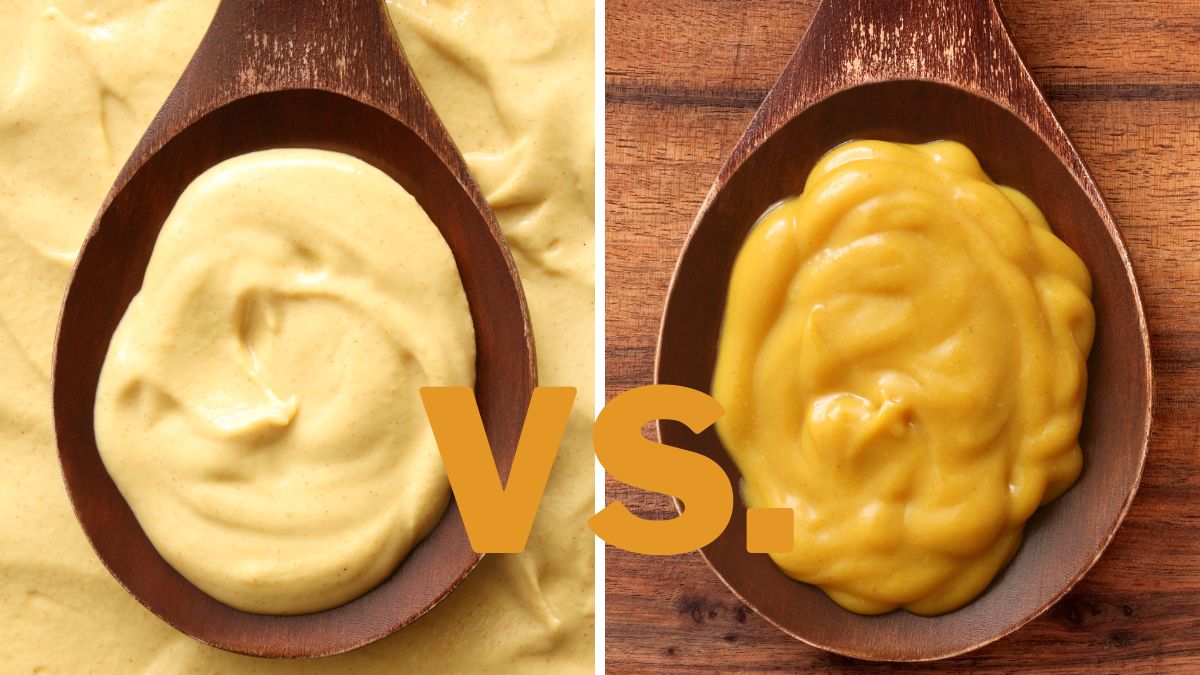Dijon Mustard vs. Yellow Mustard: Differences & Uses

When mustard comes to mind, you probably don’t think a lot before having it on your table, not caring whether it is Dijon or the good old yellow mustard. Well, I’m here to change that! Knowing about these two types of mustard has definitely made my meals tastier because I’ve learned how to combine the food with these tasty condiments. And you will do the same! So, what are the differences between Dijon and yellow mustard?
Yellow mustard is mild, while Dijon mustard is tangier and sharper. Yellow mustard is made from yellow or white mustard seeds, whereas Dijon mustard includes brown or black mustard seeds. Yellow mustard is used for hot dogs and burgers, and Dijon mustard in gourmet dishes, dressings, marinades, and sauces.
Since there are noticeable flavor and color differences between Dijon and yellow mustard, the results they offer in a dish are very different. To help you choose the right mustard for your dish, in this article, I will tell you all about Dijon and yellow mustard. If you’re lazy to read the whys, you can scroll down for all the info summarized in a table. So, hop on for the ride!
Ingredients and Preparation
Dijon mustard comes from the town of Dijon in the Burgundy region in France, hence the name reference. This type of mustard originated in the 14th century. Still, it didn’t become as popular as today until the 19th century.
Dijon mustard is traditionally made from brown or black mustard seeds, white wine or wine vinegar, water, and salt. The seeds are finely ground and combined with the other ingredients to create a smooth and creamy texture. Interestingly enough, although the original recipe calls for vinegar, in the early 19th century, it was made with juice from unripe grapes.

When it became an internationally famous and beloved household condiment, the recipe reverted back to vinegar because it was commercially more cost-effective. Anyway, the Dijon mustard we today know and love follows the vinegar recipe.
Yellow mustard is an American-made condiment you are already very familiar with. Even if you aren’t a mustard fan, chances are you have it in your pantry, just in case. To be more precise, it is much newer than Dijon mustard, i.e., six centuries.
It became popular in the early 20th century, coinciding with the hot dog’s emergence. Yellow mustard comprises yellow or white mustard seeds, vinegar (distilled or white), water, and salt. The seeds are ground and mixed with vinegar and water to achieve a smooth consistency.
So, both Dijon and yellow mustard contain very similar ingredients and go through very similar preparation processes, but the mustard seeds they use as basis create the critical difference between both mustard types.
Taste and Appearance
Taste and appearance are the aspects where the differences between Dijon and yellow mustard are the most noticeable. Although they both are made similarly using similar preparation methods, they taste and look pretty different.
Of the two, Dijon is the more sophisticated one. It has a smooth texture with a pale yellow color and a glossy appearance. It has a creamy and rich consistency, and it is very pleasing to the eye.
I like using it as a decoration for ribs or other roasts because it gives the plate a refined yet rustic vibe. I love it for its expressive tangy flavor with a very sharp flavor note, slightly bitter, and just a tad sweet.
Dijon mustard’s spiciness levels can vary depending on the brand, but in general, it isn’t supposed to be overly spicy. Since this delicious condiment is potent on its own, it doesn’t tolerate spices very well.
Yellow mustard is the condiment of the average Joe. It is bright in color, which also goes for your mood when you taste it. Just like Dijon mustard, it has a smooth texture and creamy consistency. It’s lightly glossy but not as elegant looking as Dijon mustard.
The yellow mustard flavor is similar to that of Dijon mustard, but it is noticeably milder, lighter, and brighter. While Dijon has a certain depth of flavor, yellow mustard is not as complex. It is significantly less tangy and milder. Just like Dijon, yellow mustard isn’t supposed to be very spicy, but that depends on the brand.
I like using yellow mustard with simpler foods, such as sandwiches, burgers, hot dogs, or fries, but have you heard of the TikTok trend where people try yellow mustard with watermelon? I know it sounds like an unlikely combination, and I haven’t tried it yet, but there are many videos like this one in which people recommend it. I would definitely like to know what you think about this in the comments below.
Spiciness Level
Now, as I mentioned before, neither of these two is supposed to be very spicy. Both types of mustard are potent in flavor, and they don’t do well when seasoned with strong spices. The only thing I like to add to Dijon or yellow mustard is salt to boost the rest of the flavors they offer, but I never change them by adding other spices.
Now, different brands produce different levels of spiciness, but I recommend you choose Dijon or yellow mustard brands labeled as “classic” or “traditional” to ensure that there are no other spices. Still, even the most experimental recipes don’t include too many spices.
Dijon or yellow mustard isn’t where you should experiment, and if by any chance you decide to make mustard at home, always remember that that much tang doesn’t sit well with spices.
Uses

Since Dijon and yellow mustard are significantly different in taste, they react differently with the other flavors that surround them, so it is natural for them to have different uses. Although it isn’t a crime to use Dijon mustard where yellow mustard would fit better, it is definitely a shame to use yellow mustard where Dijon would be a better solution.
Dijon mustard is more pungent, richer, and more complex than yellow mustard, and it gives the dish depth, complexity, refinement, and an edge. That’s why it has made a name in gourmet cooking, fitting perfectly in heavier and fuller dishes.
I love it with roast or as a dip for seafood. It also does great as a dressing for crab salad. Wherever you use Dijon mustard, make sure that the surrounding flavors are full and rich.
On the other hand, yellow mustard reminds me of a simpler time when all I needed was a hot dog to feel happy. And that’s just what yellow mustard does! I’ve tried Dijon on hot dogs, and to me, it just feels a little off.
Yellow mustard is the perfect condiment to use with simpler foods such as hot dogs, burgers, regular sandwiches, subs, or fries. You can also use it as a dip for fried foods, such as onion rings or chicken wings.
It also does a great job as a dressing for tuna salad or another plain green salad. Yellow mustard is potent, but it isn’t as complex and deep as Dijon mustard, so it is always a good idea to go simple with it.
Varieties
Dijon mustard comes in many varieties, such as the traditional, whole grain, spicy, and honey versions, as well as other flavored variations. Still, you should pick the classical Dijon mustard because the experimental lines might not be as good as they sound.
These variations offer unique flavor profiles and may incorporate additional ingredients like herbs, spices, or honey. I’ve tried the honey variation, and I simply love it. I make The other flavors myself, but I firmly believe that the classical Dijon mustard is the real deal.
Do a spice test at home and add a few spices you think would fit. This way, you’ll know for sure whether or not it is worth it to buy the flavored variations.
Yellow mustard has pretty much the same variations as Dijon mustard. There is the honey variation, which I love; there are also sweeter yellow mustard flavors, as well as spicy ones. Still, I would go with the traditional yellow mustard flavor and season it myself.
Substitutes
When it comes to substitutes, spicy brown mustard or whole-grain mustard can be used as alternatives for Dijon mustard. Spicy brown mustard shares a similar spiciness and depth of flavor, while whole grain mustard adds texture and a robust mustard seed presence.
On the other hand, Dijon mustard or spicy brown mustard can serve as substitutes for yellow mustard when a milder flavor is desired. In general, using one type of mustard to substitute for either yellow or Dijon mustard won’t completely substitute for all aspects, so it is best that you combine them.
And here are all these differences summarized:
| Criteria | Dijon Mustard | Yellow Mustard |
|---|---|---|
| Ingredients | Mustard seeds, white wine or wine vinegar, water, salt | Mustard seeds, vinegar (distilled or white), water, salt |
| Preparation | Ground mustard seeds mixed with other ingredients | Ground mustard seeds mixed with vinegar and water |
| Taste and Appearance | Smooth texture, pale yellow color, tangy and sharp | Smooth texture, bright yellow color, milder and tangy |
| Spiciness Level | Moderately spicy | Mildly spicy |
| Uses | Salad dressings, marinades, sauces, gourmet dishes | Hot dogs, sandwiches, burgers, basic condiments |
| Varieties | Traditional, whole grain, spicy, honey, flavored | Classic, ballpark-style, honey, spicy |
| Substitutes | Spicy brown mustard, whole grain mustard | Dijon mustard, spicy brown mustard |
Are Dijon Mustard and Yellow Mustard Interchangeable?
In general, yes, they are interchangeable, but there is a lot more to this question. You can use Dijon mustard instead of yellow and vice versa but don’t expect the same results. The former is much stronger than the latter, so using it in a hot dog may overwhelm the flavor.
On the other hand, yellow mustard might go unnoticed in more complex dishes where you would normally use Dijon mustard. Of course, every palate is different, and you may actually prefer your roast with yellow mustard and your hot dogs with Dijon, but in general, they are not as interchangeable as you may think.
Overall, my final thought is that Dijon mustard can substitute better for yellow mustard than yellow mustard can substitute for Dijon mustard.
I think it is evident from the article that my go-to for everything but hot dogs is Dijon. So, out of these two, do you prefer one over the other? I would love to read about how you use the two in the comments below!
